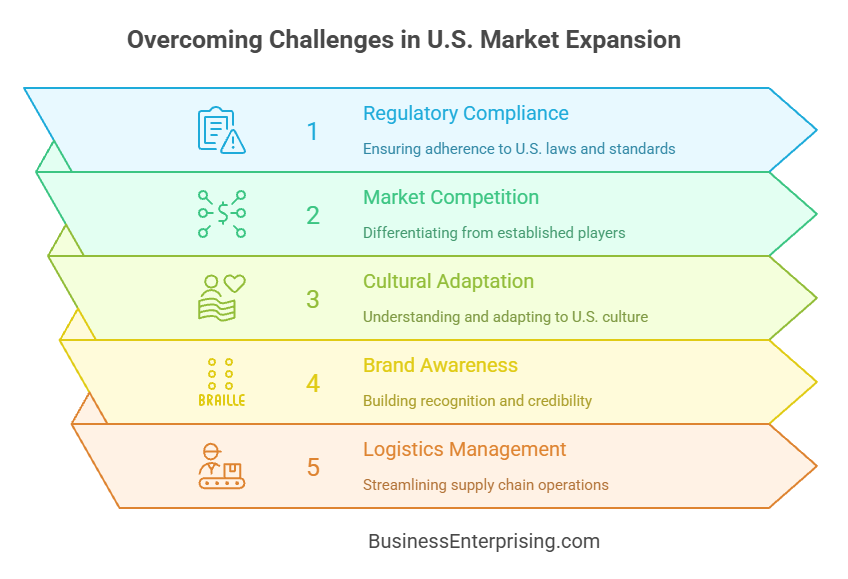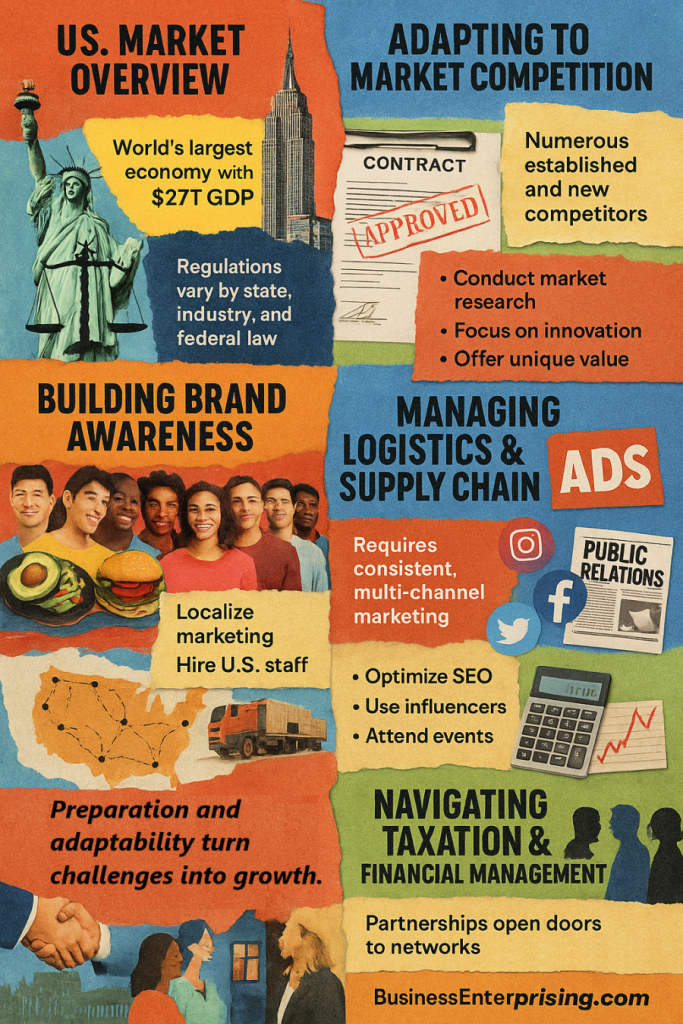
Understanding Regulatory Compliance
One of the primary challenges of entering the U.S. market is navigating its complex regulatory environment. In fact, the U.S. has stringent regulations that vary not only by state but also by industry and federal law. As a result, companies must ensure compliance with all applicable regulations, which may include labor laws, environmental standards, and industry-specific guidelines. Furthermore, failure to comply can lead to severe penalties, legal issues, and, consequently, reputational damage.
To address this challenge effectively, businesses should first engage with legal experts who specialize in U.S. regulations. These professionals can, for example, provide clear guidance on the necessary permits, licenses, and compliance measures. Moreover, companies should also invest in training for their staff so they fully understand and consistently adhere to regulatory requirements. In addition, regular audits and ongoing monitoring can help maintain compliance, identify emerging risks, and ultimately avoid potential pitfalls.
Adapting to Market Competition
The U.S. market is highly competitive, with numerous established players and new entrants vying for market share. Businesses expanding into this market must differentiate themselves and demonstrate unique value to attract customers. Understanding the competitive landscape is crucial for developing effective strategies.
Conducting comprehensive market research is essential to identify key competitors, analyze their strengths and weaknesses, and understand customer preferences. This information can inform product development, marketing strategies, and positioning. Companies should focus on innovation and continuous improvement to stay ahead of the competition. Offering superior quality, exceptional customer service, and unique features can help differentiate a business from its competitors.
Cultural Differences and Consumer Behavior
Cultural differences and varying consumer behaviors are among the biggest challenges of expanding into the U.S. market. The U.S. is a diverse country with regional variations in culture, preferences, and purchasing habits. Understanding these differences is crucial for tailoring products, services, and marketing campaigns to resonate with local consumers.
Businesses should invest in market research to gain insights into U.S. consumer behavior and preferences. This can involve surveys, focus groups, and analyzing data from existing market players. Adapting marketing messages and strategies to align with local values and norms is essential. Additionally, hiring local staff who understand the culture and market dynamics can also provide valuable insights as well as improve customer engagement. Consider consulting with American consultants for insight into these challenges.
Building Brand Awareness
Establishing brand awareness in a new market is challenging, particularly in a market as large and diverse as the U.S. Companies must invest in marketing and public relations efforts to build brand recognition and credibility. This requires a well-planned and executed marketing strategy that leverages various channels, including digital marketing, social media, and traditional advertising.
Developing a strong online presence is crucial for reaching a broad audience. Companies should optimize their websites for search engines, engage with customers on social media platforms, and create valuable content that resonates with their target audience. Partnering with local influencers and participating in industry events can also help increase visibility and build brand credibility. Consistent messaging and branding across all channels ensure a cohesive and recognizable brand image. Consider consulting with a U.S.-based marketing expert familiar with American design preferences.
Managing Logistics and Supply Chain
Managing logistics and supply chain operations in the U.S. can be complex, particularly for businesses that rely on international suppliers or operate in multiple states. The vast geography and varying regulations across states can complicate transportation, warehousing, and distribution.
To overcome these challenges, businesses should develop a robust logistics and supply chain strategy. This may involve partnering with local logistics providers, investing in technology to streamline operations, and optimizing inventory management. Utilizing advanced analytics and real-time tracking systems can enhance visibility and efficiency in the supply chain. Additionally, companies should also establish contingency plans to address potential disruptions and ensure continuity of operations.
Navigating Taxation and Financial Management
The U.S. tax system is intricate, with federal, state, and local taxes that businesses must navigate. Understanding the tax implications and ensuring compliance is crucial to avoid penalties as well as financial issues. Additionally, managing finances in a new market also requires careful planning and monitoring.
Engaging with financial advisors and tax experts who specialize in U.S. regulations can provide valuable guidance. These professionals can help businesses understand their tax obligations, optimize their tax strategy, and ensure compliance. Implementing robust financial management systems and practices can enhance financial visibility and control. Regular financial reviews and audits can help identify potential issues and ensure the business remains financially healthy.
Leveraging Local Partnerships and Resources
Building local partnerships and leveraging resources can significantly ease the process of expanding into the U.S. market. Partnering with local businesses, industry associations, and chambers of commerce can provide valuable support and insights. These partnerships can facilitate market entry, enhance credibility, and provide access to local networks.
Additionally, utilizing resources such as government programs, trade associations, and business incubators can also provide valuable support and funding opportunities. These resources can offer guidance on regulatory compliance, market entry strategies, and financial assistance. Engaging with local communities and participating in networking events can also help build relationships and increase visibility.
Conclusion
The challenges of expanding into the U.S. market are extensive, from navigating regulatory compliance and managing competition to understanding cultural differences as well as building brand awareness. However, with thorough preparation, strategic planning, and leveraging local expertise, businesses can successfully overcome these challenges and achieve growth in this lucrative market.
In conclusion, entering the U.S. market requires a comprehensive approach that addresses regulatory, competitive, cultural, logistical, and financial aspects. By investing in market research, adapting strategies to local preferences, building strong partnerships, and leveraging available resources, businesses can navigate the complexities of the U.S. market and capitalize on the opportunities it offers. As the business landscape continues to evolve, staying informed and adaptable will be key to achieving long-term success in the U.S. market.


